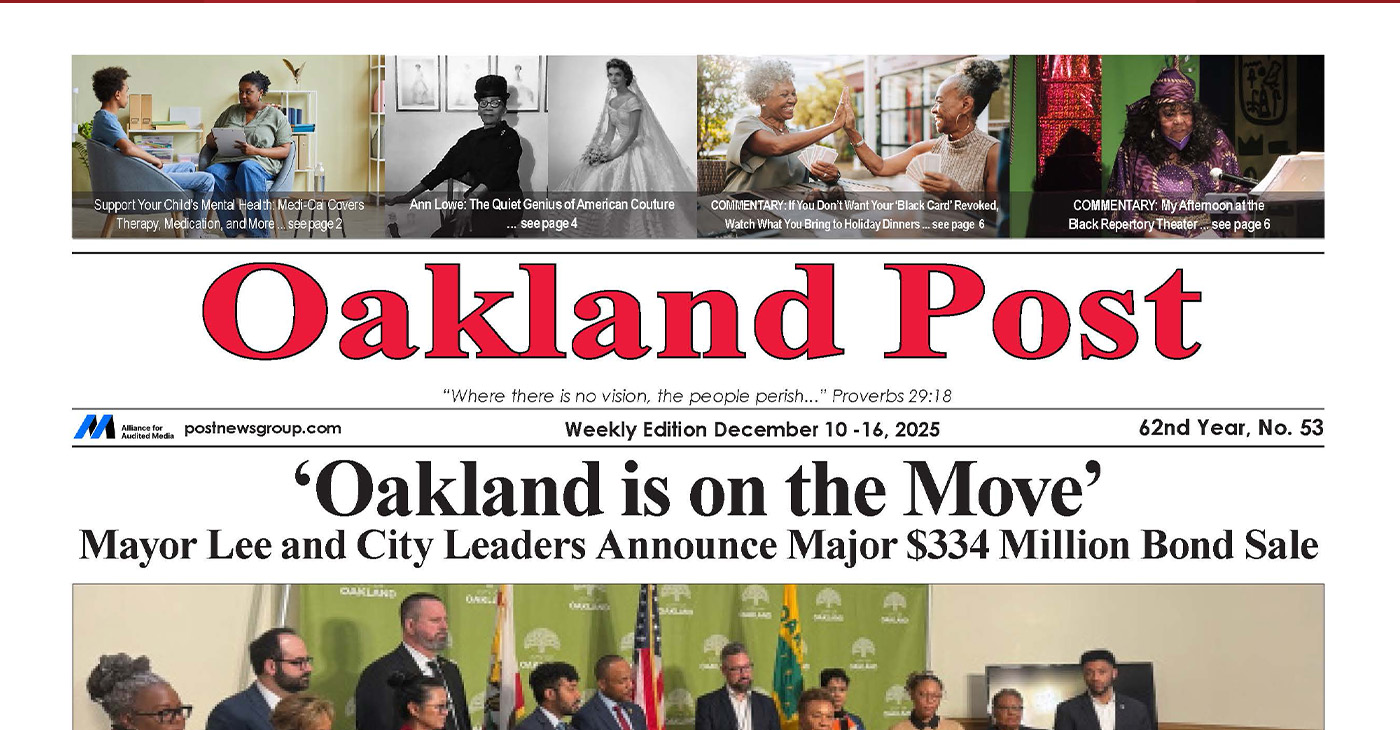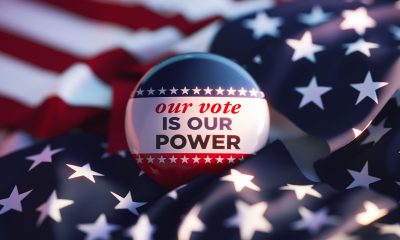National
Teachers with Subconscious Bias Punish Blacks More Severely

“We discovered, the more likely teachers thought a student was Black, the more harshly they wanted to punish them,” said Jason Okonofua, a doctoral student at Stanford University and co-author of the study, “Two Strikes: Race and the Disciplining of Young Students.” (Courtesy Photo)
By Jazelle Hunt
NNPA Washington Correspondent
WASHINGTON (NNPA) – When teachers harbor subconscious racial bias, they are far more likely to discipline White students less severely than African Americans, according to a new study.
As early as kindergarten, Black girls are being suspended at six times the rate of White girls, and more than all boys except fellow African Americans. Black boys are being suspended at three times the rate of White boys. According to 2010 figures from the Department’s Civil Rights Data Collection, 44 percent of those suspended more than once that year, and 36 percent of those expelled were Black – despite being less than 20 percent of the student population.
“Stereotypes serve as sort of a glue that sticks separate encounters together in our mind and lead us to then respond more negatively,” says Jason Okonofua, doctoral student at Stanford University and co-author of the study, “Two Strikes: Race and the Disciplining of Young Students.”
“In the study we have…the stereotype that the student is a ‘troublemaker’ leads the teacher to see two separate instances of misbehavior as constituting a pattern. Therefore following the second misbehavior there’s a sharp escalation in how severely the teacher wants to discipline a Black child.”
This is known as the “Black escalation effect.” As the number of behavioral issues increases, it is perceived as more of a threat to the classroom if the doer is Black. Black escalation leads teachers to discipline Black students faster and more harshly than their White counterparts, even when the students have the same number and types of offenses.
In the study, which appears in the April issue of Psychological Science, 53 teachers, all women, mostly White, were given a school record for a hypothetical student. Each record detailed two minor misbehaviors (classroom disruption and insubordination) – some for a hypothetical child named Darnell or Deshawn, others for a hypothetical child named Jake or Greg.
On average, teachers responded the same way to Darnell, Deshawn, Greg, and Jake on their first misbehaviors. But on the second offense, they were more likely to punish the boys they perceived as Black, more likely to issue harsher punishments to them, and more likely to label them “troublemakers.”
All of the participants were current K-12 teachers with an average of 14 years of experience.
“We discovered, the more likely teachers thought a student was Black, the more harshly they wanted to punish them,” Okonofua says. “That’s surprising because all we manipulated in the study was the names. But it’s not just the student’s name, it’s the level of Blackness teachers think the student is.”
The teachers in the study also reported feeling “more troubled” over second offenses when they perceived the student as Black (also by their own report). Further, when the students were perceived as Black, the teachers were more likely to report that they could see themselves suspending him in the future.
Stereotypes largely drive the Black escalation effect. Black children are more likely to be stereotyped as aggressive, defiant, and learning-disabled; when Black children misbehave and are disciplined, these stereotypes can kick in and result in harsher reactions.
Okonofua says, “Most school teachers work hard at treating their students equally. And yet, even among these well-intentioned and hardworking people, we find that cultural stereotypes about Black people are bending people’s perceptions toward less favorable interpretations of Black students’ behavior.”
The Department of Education estimates that 2014 was the first year students of color and White students reached equal numbers in the nation’s elementary and middle schools. Among kids under 5 years old, children of color are already the majority.
Most teacher training programs are not equipped to prepare future teachers for the realities of multiracial classrooms. But some programs have begun to recognize the impact this has on educational outcomes for the nation’s students of color.
“Part of the challenge of this is, for racial bias to even be brought to the table it requires a certain level of racial consciousness on the part of the teacher educator,” said Tyrone Howard, professor of education at University of California, Los Angeles.
“Ninety percent of all teacher educators are White. And by and large, most White people don’t think about issues of race.”
In addition to training teachers, Howard serves as the founding director of UCLA’s Black Male Institute to improve educational outcomes for Black boys, as well as the faculty director of UCLA Center X, a program that cultivates social justice-minded teachers for low-income Los Angeles public schools.
In his experience, White aspiring teachers tend to be uncomfortable or annoyed when he brings racism, stereotypes, and bias into his instruction. Meanwhile, he says, aspiring teachers of color often feel marginalized and unprepared for classrooms when their training programs avoid discussions on race.
“When I was in the Midwest, where the majority of my [education] students were White, there’s oftentimes a reticence to engage in that work while they’re in the program,” he says, adding that he was often told he made White people uncomfortable. “But once they’ve had the opportunity to understand that race is ever-present and that students of color are always watchful of what they say, what they do, and how they act…then [teachers] begin to see ‘Wow, I didn’t realize these issues were real.’”
Another challenge is that few programs have a system in place to verify whether their anti-bias training is effective once education students enter real classrooms.
But such programs are the exception. Most teachers receive little to no discussion or training on these issues – and in most states, this has no bearing on the requirements for earning teaching credentials.
For teachers who lack access to adequate anti-bias, anti-racist training, Okonofua has found through other research that refocusing on maintaining warm relationships with each student weakens the effect of subconscious biases.
Howard believes that without formal interventions, the effort to make teachers more culturally competent and will be too little, too late.
He says: “As long as states and credentialing commissions don’t make this a staple of what is required for credentials, it will always be looked at as optional or it will always be on the fringes.”
###
Activism
Oakland Post: Week of December 10 – 16, 2025
The printed Weekly Edition of the Oakland Post: Week of – December 10 – 16, 2025

To enlarge your view of this issue, use the slider, magnifying glass icon or full page icon in the lower right corner of the browser window.
Alameda County
Seth Curry Makes Impressive Debut with the Golden State Warriors
Seth looked comfortable in his new uniform, seamlessly fitting into the Warriors’ offensive and defensive system. He finished the night with an impressive 14 points, becoming one of the team’s top scorers for the game. Seth’s points came in a variety of ways – floaters, spot-up three-pointers, mid-range jumpers, and a handful of aggressive drives that kept the Oklahoma City Thunder defense on its heels.

By Y’Anad Burrell
Tuesday night was anything but ordinary for fans in San Francisco as Seth Curry made his highly anticipated debut as a new member of the Golden State Warriors. Seth didn’t disappoint, delivering a performance that not only showcased his scoring ability but also demonstrated his added value to the team.
At 35, the 12-year NBA veteran on Monday signed a contract to play with the Warriors for the rest of the season.
Seth looked comfortable in his new uniform, seamlessly fitting into the Warriors’ offensive and defensive system. He finished the night with an impressive 14 points, becoming one of the team’s top scorers for the game. Seth’s points came in a variety of ways – floaters, spot-up three-pointers, mid-range jumpers, and a handful of aggressive drives that kept the Oklahoma City Thunder defense on its heels.
One of the most memorable moments of the evening came before Seth even scored his first points. As he checked into the game, the Chase Center erupted into applause, with fans rising to their feet to give the newest Warrior a standing ovation.
The crowd’s reaction was a testament not only to Seth’s reputation as a sharpshooter but also to the excitement he brings to the Warriors. It was clear that fans quickly embraced Seth as one of their own, eager to see what he could bring to the team’s championship aspirations.
Warriors’ superstar Steph Curry – Seth’s brother – did not play due to an injury. One could only imagine what it would be like if the Curry brothers were on the court together. Magic in the making.
Seth’s debut proved to be a turning point for the Warriors. Not only did he contribute on the scoreboard, but he also brought a sense of confidence and composure to the floor.
While their loss last night, OKC 124 – GSW 112, Seth’s impact was a game-changer and there’s more yet to come. Beyond statistics, it was clear that Seth’s presence elevated the team’s performance, giving the Warriors a new force as they look to make a deep playoff run.
#NNPA BlackPress
LIHEAP Funds Released After Weeks of Delay as States and the District Rush to Protect Households from the Cold
BLACKPRESSUSA NEWSWIRE — The federal government has released $3.6 billion in home heating assistance after a delay that left states preparing for the start of winter without the program’s annual funding.

By Stacy M. Brown
Black Press USA Senior National Correspondent
The federal government has released $3.6 billion in home heating assistance after a delay that left states preparing for the start of winter without the program’s annual funding. The Low-Income Home Energy Assistance Program, known as LIHEAP, helps eligible households pay heating and cooling bills. The release follows a shutdown that stretched 43 days and pushed agencies across the country to warn families of possible disruptions.
State officials in Minnesota, Kansas, New York, and Pennsylvania had already issued alerts that the delay could slow the processing of applications or force families to wait until December for help. In Pennsylvania, more than 300,000 households depend on the program each year. Minnesota officials noted that older adults, young children, and people with disabilities face the highest risk as temperatures fall.
The delay also raised concerns among advocates who track household debt tied to rising utility costs. National Energy Assistance Directors Association Executive Director Mark Wolfe said the funds were “essential and long overdue” and added that high arrearages and increased energy prices have strained families seeking help.
Some states faced additional pressure when other services were affected by the shutdown. According to data reviewed by national energy advocates, roughly 68 percent of LIHEAP households also receive nutrition assistance, and the freeze in multiple programs increased the financial burden on low-income residents. Wolfe said families were placed in “an even more precarious situation than usual” as the shutdown stretched into November.
In Maryland, lawmakers urged the Trump administration to release funds after the state recorded its first cold-related death of the season. The Maryland Department of Health reported that a man in his 30s was found outdoors in Frederick County when temperatures dropped. Last winter, the state documented 75 cold-related deaths, the highest number in five years. Rep Kweisi Mfume joined more than 100 House members calling for immediate federal action and said LIHEAP “is not a luxury” for the 100,000 Maryland households that rely on it. He added that seniors and veterans would be placed at risk if the program remained stalled.
Maryland Gov. Wes Moore used $10.1 million in state funds to keep benefits moving, but noted that states cannot routinely replace federal dollars. His administration said families that rely on medical equipment requiring electricity are particularly vulnerable.
The District of Columbia has already mapped out its FY26 LIHEAP structure in documents filed with the federal government. The District’s plan shows that heating assistance, cooling assistance, weatherization, and year-round crisis assistance operate from October 1 through September 30. The District allocates 50 percent of its LIHEAP funds to heating assistance, 10 percent to cooling, 13 percent to year-round crisis assistance, 15 percent to weatherization, and 10 percent to administrative costs. Two percent is used for services that help residents reduce energy needs, including education on reading utility bills and identifying energy waste.
The District’s plan lists a minimum LIHEAP benefit of $200 and a maximum of $1,800 for both heating and cooling assistance. Crisis benefits are provided separately and may reach up to $500 when needed to resolve an emergency. The plan states that a household is considered in crisis if it has been disconnected from energy service, if heating oil is at 5 percent or less of capacity, or if the household has at least $200 owed after the regular benefit is applied.
The District’s filing notes that LIHEAP staff conduct outreach through community meetings, senior housing sites, Advisory Neighborhood Commissions, social media, posters, and mass mailings. The plan confirms that LIHEAP applicants can apply in person, by mail, by email, or through a mobile-friendly online application and that physically disabled residents may request in-home visits.
As agencies nationwide begin distributing the newly released funds, states continue working through large volumes of applications. Wolfe said LIHEAP administrators “have been notified that the award letters have gone out and the states can begin to draw down the funds.”
-

 Activism4 weeks ago
Activism4 weeks agoOakland Post: Week of November 12 – 18, 2025
-

 Activism3 weeks ago
Activism3 weeks agoIN MEMORIAM: William ‘Bill’ Patterson, 94
-

 Activism4 weeks ago
Activism4 weeks agoHow Charles R. Drew University Navigated More Than $20 Million in Fed Cuts – Still Prioritizing Students and Community Health
-

 Bay Area4 weeks ago
Bay Area4 weeks agoNo Justice in the Justice System
-

 #NNPA BlackPress3 weeks ago
#NNPA BlackPress3 weeks agoBeyoncé and Jay-Z make rare public appearance with Lewis Hamilton at Las Vegas Grand Prix
-

 #NNPA BlackPress3 weeks ago
#NNPA BlackPress3 weeks agoLewis Hamilton set to start LAST in Saturday Night’s Las Vegas Grand Prix
-

 Activism3 weeks ago
Activism3 weeks agoOakland Post: Week of November 19 – 25, 2025
-

 #NNPA BlackPress4 weeks ago
#NNPA BlackPress4 weeks agoThe Perfumed Hand of Hypocrisy: Trump Hosted Former Terror Suspect While America Condemns a Muslim Mayor


















































